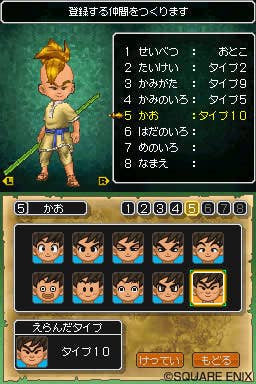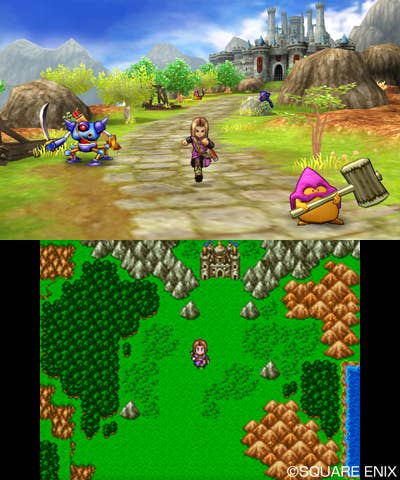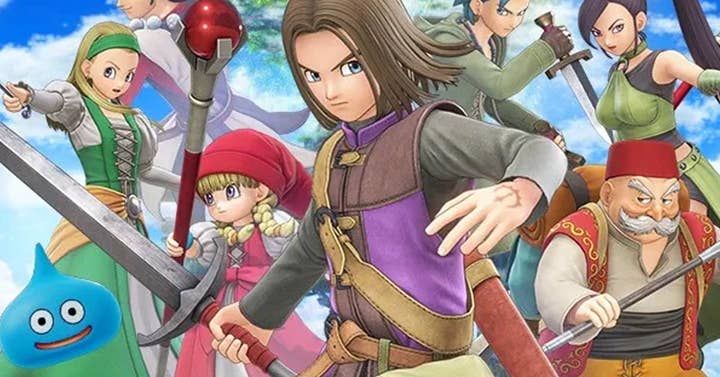What can Dragon Quest 12 learn from a 2009 Nintendo DS game?
A look at Square Enix's struggles to bring the RPG series to the West while still appealing to its core fans in Japan
In September 2020, Square Enix announced that Dragon Quest 11 had shipped over six million units worldwide, making it the highest selling game in the series so far.
On the surface, those are promising numbers. But if you were to look a little more closely, it took Square significantly more time, effort, and money to reach those numbers than it should have -- and Dragon Quest 11 may have been a slightly misguided affair on the whole. Taking a look at the game's history and development offers insight into the challenges Square Enix faces with Dragon Quest 12 and the future of the series.
Dragon Quest 11 was first mentioned by series creator Yuji Horii in 2014, in which he indicated it was being developed for home consoles, as opposed to portable platforms like the last several Dragon Quest games before it. It felt like an odd decision, given that Dragon Quest is largely a Japan-centric franchise, and the market for home console games had all but dried up there.
There was only one explanation: Square Enix was thinking beyond Japan.
This was obviously a risk. Dragon Quest's popularity lies in the generations of Japanese families have grown up playing the games. Even people that don't typically play video games play Dragon Quest -- sort of like FIFA or Madden. So Square Enix's general approach to the series had historically been to make games for whatever the most popular platform in Japan was.

Case in point: 2009 DS title Dragon Quest 9, was played by everyone from 18-year-old men to 60-year-old women. This was partly due to the fact that 20% of Japan's population owned a DS, and partly because Dragon Quest 9 itself was a highly cognizant product designed around the intricacies of the Japanese market.
At the time, co-op multiplayer games were starting to become trendy in Japan, prompted by the success of Monster Hunter and Animal Crossing. And so, Square Enix designed Dragon Quest 9 with co-op multiplayer and the ability to customize the looks and equipment of your entire party.
A key feature was Tag Mode, which enabled players to wirelessly exchange in-game treasure maps simply by carrying their DS around. These maps led to rare enemies and items, further incentivizing players to meet up and exchange. Square Enix even set up Patty's Pub, an inn from the game, as a real-life destination in Tokyo to facilitate these meet-ups. Revolutionary game design for the time, the map exchange communication would later inspire Nintendo to make the 3DS' StreetPass feature.
Dragon Quest 9 tapped into the audience it had nurtured over two decades, and attracted younger players as well. It has sold over 4.4 million units in Japan alone, where it still remains the highest selling Dragon Quest game released on any single platform.
Dragon Quest had never been designed for Western tastes. In fact, the things Japan adored about it were precisely the things Western audiences disliked
By the time development started on Dragon Quest 11 in 2013,, the Japanese video game market had deteriorated significantly and Square Enix was a very different company. For starters, the birthrate had declined drastically; with only a million children being born that year, concerns arose that, some day in the future, there were going to be far fewer new video game fans left to cater to. Meanwhile, the troubled development cycles of Final Fantasy 13, Final Fantasy 15, and Final Fantasy Versus 13 had turned Square Enix Japan into a much more conservative publisher, the vast majority of its development split between gacha-driven smartphone games and the occasional AAA title.
To top it all off, the 3DS hadn't been nearly as successful as the DS before it, and industry pundits were predicting the impending death of handhelds in the wake of the smartphone boom. And so, Square Enix presumably took the only route it felt was feasible for the next Dragon Quest: it looked to the West, where big-budget AAA games on the PlayStation 4 were king.
Here's the problem: Dragon Quest had never been designed for Western tastes. In fact, the things that Japan adored about Dragon Quest were precisely the things Western audiences disliked, viewing it as a conservative, linear, and slow-to-evolve Japanese RPG that prided itself on being especially archaic. Dragon Quest 9 had broken that mold, and Square Enix expanded upon its ideas in Dragon Quest 10, a Japan-exclusive MMORPG. However, Dragon Quest 11, the series' next 'main event,' was to be a conscious return to the old formula, which had limited Western appeal.
Square Enix was undoubtedly aware of these challenges but committed to its plan, regardless. Dragon Quest 11 was going to be a big-budget PlayStation 4 game -- fancier visuals, an open world, and a story told through high-quality CG cutscenes. 2014's Dragon Quest Heroes, an action RPG for PS3 and PS4, aimed to cultivate an audience for 11, which was announced a year later for the PS4, 3DS, and Nintendo's next platform, the 'NX' (today known as the Nintendo Switch).

The 3DS version was greenlit after internal discussions determined that the PS4 game alone wouldn't reach a wide enough audience in Japan. While Square was hoping to appeal to the West, the vast majority of the Dragon Quest audience was still in its home market -- and smartphone boom or not, the 3DS was still the dominant platform in Japan by a very wide margin.
On 3DS, the game would share its story and scope with the PS4 version -- a high-spec, Unreal Engine-fueled, Final Fantasy-esque game -- but differ greatly in terms of presentation and game design. It would even allow the player to switch between a regular 3D mode and a 'classic' top-down SNES-style RPG mode, aimed primarily at older Dragon Quest fans. The Switch version would then combine features from both the PS4 and 3DS games.
It was clear that Horii and his team wanted to cover all their bases: an indulgent, AAA version of Dragon Quest 11 for PS4 and a more 'responsible' version for 3DS, should the PS4 SKU fail to find an audience. The classic mode on 3DS, and the fact the Switch version would eventually need to be made using an entirely different build of Unreal -- since the older PS4 version wouldn't play ball with the new hardware -- meant Square Enix was effectively working on four entirely different versions of a single game. Anyone with an eye for the Japanese games industry could have predicted what happened next.

Following Dragon Quest XI's release in 2017, Square Enix reported it had shipped three million units across PS4 and 3DS. The more expensive PS4 version met expectations in terms of earned revenue, but the 3DS version wasn't doing quite as well as Square had hoped -- and the publisher had been counting on it to reach a wider user base. While the 3DS version had sold more units, it was also less expensive, which meant Square Enix made less money on each copy sold, so it failed to offset the price difference.
What the publisher had failed to take into account was that by 2017, the Switch was already out and the 3DS was at the very end of its tenure. And with the Switch version of Dragon Quest 11 still a few years away, it meant that Square missed the boat with both of Japan's dominant gaming platforms.
So, to recap: three bespoke versions of Dragon Quest 11 across 3DS and PS4. Time and money was poured into a big-budget console version, effectively holding back the portable version intended to sell more and reach a wider audience in its home market. And all lacked the customization and communication features that are imperative for a multi-million seller in Japan. These factors ultimately resulted in Dragon Quest 11 selling less than Dragon Quest 9 -- a Nintendo DS game developed on a fraction of the budget -- in its home market.
Square Enix needed its bet on the West to pay off; in 2021, it's difficult to determine whether it has done so
It felt like Dragon Quest was falling into the same trap Final Fantasy had, where exorbitant budgets often did more harm than good. Due to the massive investment in the PS4 version, Square Enix needed its bet on the West to pay off; skip forward to 2021, and it's difficult to determine whether it has done so. Dragon Quest 11 shipped over six million units worldwide, yes, but it took the combined sales of the PS4, 3DS, Switch, and PC versions to get there.
In contrast, Dragon Quest 9 sold 5.3 million units worldwide on the Nintendo DS alone, elevated purely by intelligent design and marketing. And, to really drive the point home, the vast majority of Dragon Quest 11's sales are still from Japan, making both the game and Square's strategy easy to question.
Square Enix has since taken some smart measures to put Dragon Quest 11 in the hands of more Western players. It's made the game available via GamePass on PC and Xbox, enabling subscribers to try it out for "free" while the publisher reaps the benefits of whatever arrangement it has with Microsoft. But the point still stands: Dragon Quest just isn't as popular in the West as Final Fantasy or Persona, and without some drastic changes it never will be.
Square Enix has already confirmed Dragon Quest 12 is in development, but who is the game being made for: Japan or the West?
In truth, it doesn't need to be one or the other. Dragon Quest 9, with its multiplayer and communication elements, character creation, and customization-heavy design, is still the most forward-thinking entry Square Enix has ever made. And while it was created with Japanese audiences in mind, those specific features are universally popular. Given that Square recently touched on the idea for a remake of Dragon Quest 9, one would imagine it, too, understands the importance of that game.
Of course, it's also important for Square Enix to be smarter about its platform choices -- luckily, the market is much easier to read than it was in 2014. The Nintendo Switch is presently the only platform that is viable both in Japan and the West, so there's no confusion around where future Dragon Quest games will find the largest audience. The recent release of Monster Hunter Rise -- which has shipped over six million units worldwide, half of that in Japan alone -- further demonstrates that targeting Switch is a must for any game that hopes to be successful on both sides of the pond.
Naturally, it isn't quite as simple as all that -- especially if Square Enix is seriously committed to making Dragon Quest a more palatable brand in the West. That requires a ground-up re-examination of the series, starting with character designs and setting and extending all the way to other features like the battle system.
Whether or not Square is considering this sort of radical reinvention the way it did with Dragon Quest 9 remains to be seen, but one expects we'll get a glimpse of its plans later today, during the series' 35th Anniversary Special livestream.
This article originally stated Dragon Quest 9's release year as 2008, when it was in fact 2009. The text and the headline has been updated accordingly.
